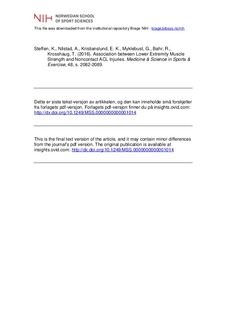| dc.contributor.author | Steffen, Kathrin | |
| dc.contributor.author | Nilstad, Agnethe | |
| dc.contributor.author | Kristianslund, Eirik Klami | |
| dc.contributor.author | Myklebust, Grethe | |
| dc.contributor.author | Bahr, Roald | |
| dc.contributor.author | Krosshaug, Tron | |
| dc.date.accessioned | 2017-11-14T11:38:05Z | |
| dc.date.available | 2017-11-14T11:38:05Z | |
| dc.date.issued | 2016 | |
| dc.identifier.citation | Medicine & Science in Sports & Exercise. 2016, 48, 2082-2089 | nb_NO |
| dc.identifier.uri | http://hdl.handle.net/11250/2466143 | |
| dc.description | I Brage finner du siste tekst-versjon av artikkelen, og den kan inneholde ubetydelige forskjeller fra forlagets pdf-versjon. Forlagets pdf-versjon finner du på insights.ovid.com / In Brage you'll find the final text version of the article, and it may contain insignificant differences from the journal's pdf version. The definitive version is available at insights.ovid.com | nb_NO |
| dc.description.abstract | Purpose: This study aimed to prospectively investigate the association between isolated and functional lower extremity muscle strength and the risk for noncontact anterior cruciate ligament (ACL) injury in Norwegian female elite handball and football players. Methods: From 2007 through 2015, premier league players participated in strength testing and were prospectively followed for ACL injury risk. At baseline, we recorded player demographics, playing and ACL injury history, and measured peak concentric isokinetic quadriceps and hamstring torques (60°·s−1), hamstring-to-quadriceps ratio, isometric hip abduction strength, and one-repetition maximum in a seated leg press. We followed a predefined statistical protocol where we generated five separate logistic regression models, one for each of the proposed strength risk factors and adjusted for confounding factors. New ACL injury was the outcome, using the leg as the unit of analysis. Results: A total of 57 (6.6%) of 867 players (age = 21 ± 4 yr, height = 170 ± 6 cm, body mass = 66 ± 8 kg) suffered from a noncontact ACL injury after baseline testing (1.8 ± 1.8 yr). The OR of sustaining a new injury among those with an ACL injury history was 3.1 (95% confidence interval = 1.6–6.1). None of the five strength variables selected were statistically associated with an increased risk of ACL rupture when adjusted for sport, dominant leg, ACL injury history, and height. Conclusion: Peak lower extremity strength was not associated with an increased ACL injury risk among female elite handball and football players. Hence, peak strength, as measured in the present study, cannot be used to screen elite female athletes to predict injury risk. | nb_NO |
| dc.language.iso | eng | nb_NO |
| dc.publisher | Ovid | nb_NO |
| dc.subject | female | nb_NO |
| dc.subject | handball | nb_NO |
| dc.subject | football | nb_NO |
| dc.subject | anterior cruciate ligament | nb_NO |
| dc.subject | muscle strength | nb_NO |
| dc.subject | screening | nb_NO |
| dc.subject | injury risk | nb_NO |
| dc.title | Association between Lower Extremity Muscle Strength and Noncontact ACL Injuries | nb_NO |
| dc.type | Journal article | nb_NO |
| dc.type | Peer reviewed | nb_NO |
| dc.source.journal | Medicine & Science in Sports & Exercise | nb_NO |
| dc.identifier.doi | 10.1249/MSS.0000000000001014 | |
| dc.description.localcode | Seksjon for idrettsmedisinske fag / Department of Sports Medicine | nb_NO |
